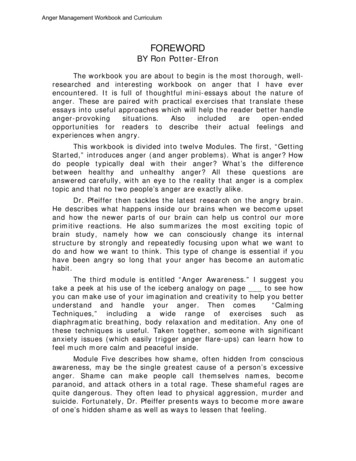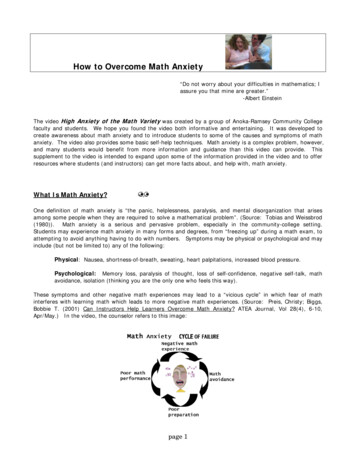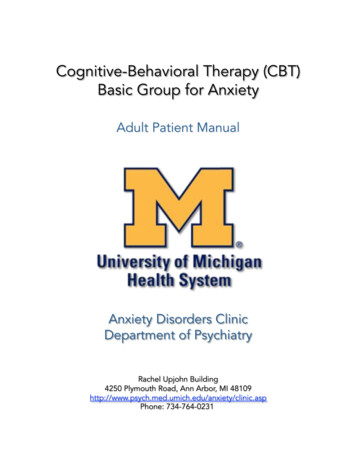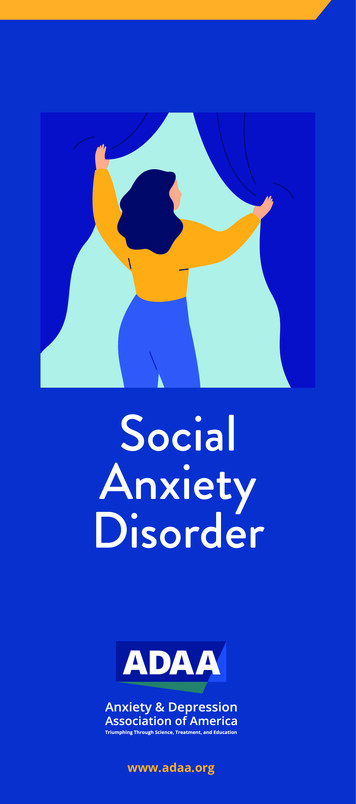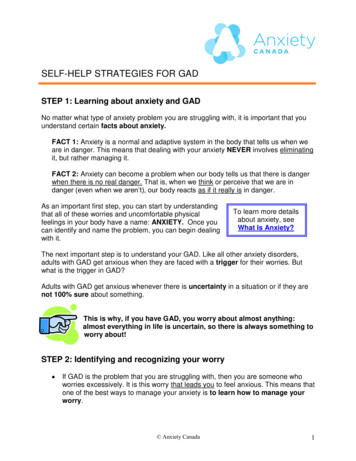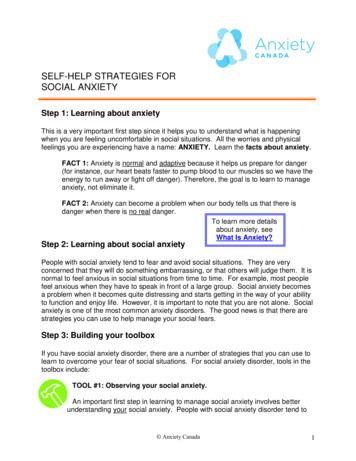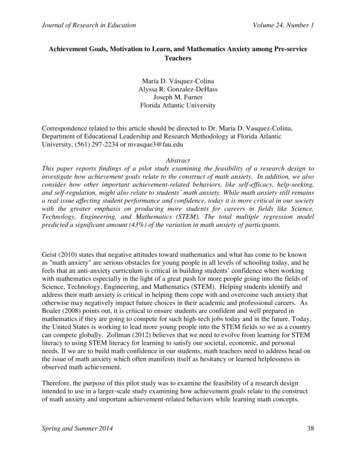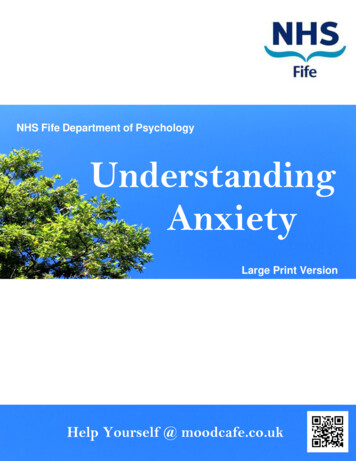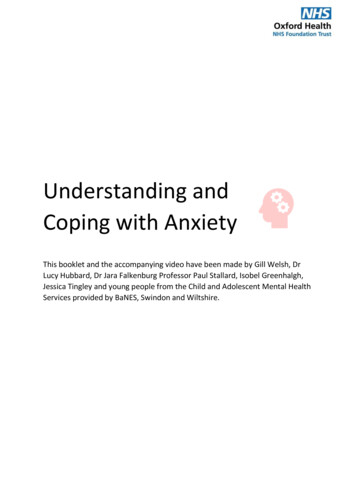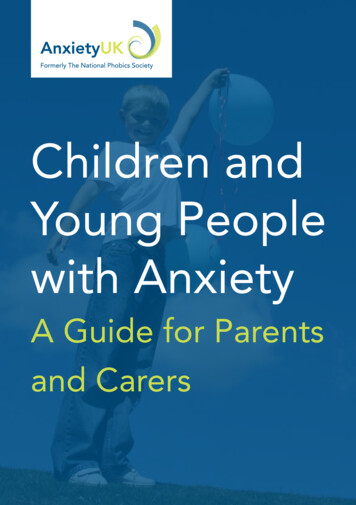
Transcription
Volume: 2 Issues: 5 [September, 2017] pp.99-119]International Journal of Education, Psychology and CounselingeISSN: 0128-164XJournal website: www.ijepc.comMATHEMATICS ANXIETY AND ITS IMPACT ON THE COURSEAND CAREER CHOICE OF GRADE 11 STUDENTSMariella Espino1Jubille Pereda1Jesamie Recon1Elizabeth Perculeza1Clarice Umali11University of Batangas Lipa City, Batangas.Accepted date: 29 July 2017Published date: 2 October 2017To cite this document:Espino, M., Pereda, J., Recon, J., Perculeza, E., & Umali, C. (2017). Mathematics Anxiety and ItsImpact on the Course And Career Choice of Grade 11 Students. International Journal ofEducation, Psychology and Counselling, 2(5), 99-119.Abstract: This study evaluates mathematics anxiety and its impact on the career choice ofgrade-11 students. The descriptive method of research was used to determine the impact ofMathematics anxiety over their choice of track for Senior High. A structured questionnaire wasmade by the researchers for the purpose of gathering information for the study. It includes thecauses of students’ Mathematics anxiety, and the effects of Mathematics anxiety on the courseand career choice among Grade-11 students. Before constructing the questionnaire, theresearchers made an interview to those Grade- 11 students. Based on the interview theresearchers found out the factors that causes students mathematics anxiety. And these factorsare: the teachers, students’ perception towards Math, students’ behaviour/ attitude towardsMath, students’ experiences in attending math class, and taking math exams. It helps theresearchers to make the questionnaire. After retrieving the accomplished copies of thequestionnaire, result were tallied, tabulated and treated statistically. The researchers made useof a four-point scale in which one (1) corresponds to the lowest and four (4) corresponds as thehighest. Other statistical tools that were used in the study are ranking, weighted mean andcomposite mean. The results show that there is a significant relationship between mathematicsanxiety and the course and career choice of Grade-11 students. Because of mathematicsanxiety, most of the respondents tend to choose Humanities and Social Sciences (HUMMS) astheir study track. The researchers found out that mathematics anxiety has a big effect on thecourse and career choice of Grade-11 students. The foregoing findings and conclusions pavedway for the researchers to recommend measures to solve students’ mathematics anxiety.Keywords: Mathematics Anxiety; Course; Career Choice99
IntroductionMath anxiety is the feeling of worry, frustration, agitation, and a fear of failure about taking amath class, completing math problems, and taking a math exam. Being anxious about math canbegin when a child is in fourth grade and generally increases when students are in middle andhigh school. Some studies have focused on students as young as first-grade experiencing mathanxiety (Harari, Vukovic& Bailey, 2013). It also involves feelings of tension and anxiety thatinterfere with the manipulation of numbers and the solving of mathematical problems in a widevariety of ordinary life and academic situations. Many adults, with and without disabilities, donot feel confident in their ability to do math (Duffy & Furner, 2002). The most intuitivedefinition of math anxiety is a fear of math. Quantiphobia (Goldberg & Waxman, 2003),mathophobia (Hilton, 1980), math phobia (Pan & Tang, 2005), and Mathematics LearningDistress (MALEI, 2006) are descriptive phrases that represent the same phenomenon.One of the common goals of all mathematics teachers at all levels of education is that studentsshould understand and learn mathematics. Various factors are involved in shaping theunderstanding and learning of mathematics. Teachers’ attitudes and behaviors have a greatimpact to the students when it comes to educational growth (Demanet & Van Houtte, 2012).Attitudes and behaviour shown by the teachers shapes their students’ performance in the class,be it negative or positive. However, teachers can reduce math anxiety and are an importantelement in encouraging students to attain high level mathematics (Scapello, 2007). Wheneverstudents feel that teachers have a low expectation for them, they show less interest on thesubject. This affects their performance and shows a slow academic progress. However, one ofthe prerequisites for understanding mathematics is interest in math and the desire of students tolearn it. Interest is a stimulus that increases the activity power. Simultaneous to active learning,students should be interested in the subject they are learning and students may resort to it inorder to understand the materials and apply them. Therefore, it is necessary to further examinethe factors involved in making students interested in math so that no one would hear statementssuch as “Not too sweet course of math!,” “Wow! The boring math class!,” “Monster math!”Now the question is, why should these students often lose interest and may be forced to put upa math class?Beilock (2008) stated that when students are put in stressful environments that induce strongfeelings of pressure, they tend to perform poorly and sometimes below their actual abilitywhich, consequently, can contribute to mathematics anxiety. She explained that mathematicsanxiety coupled with stressful situations compromises one’s mathematical working memory, “ashort-term system involved in the regulation and control of information relevant to the task athand” (Maloney &Beilock, 2012, p. 404). Two theories were proposed to justify how pressurecan have negative effects on performance: the explicit monitoring theory and the distractiontheory. When students are presented with a mathematical task in a highly stressful situation, theexplicit monitoring theory proposes that mathematics-anxious students have a tendency to focuson their worries and self-doubts (Beilock& Carr, 2001). These intrusive thoughts maypreoccupy the students with thoughts of “one’s dislike or fear of mathematics or one’s lowselfconfidence, thus, acting like a secondary task and distracting attention away from the math”(Cavanagh, 2007, p. 10). The distraction theory describes highly stressful situations in which100
the students’ working memory needed to carry out the mathematics in a task is superseded bythe pressure of accurately completing the tasks as well as the consequences that may follow asa result of performing below expectations. As a result, students who rely heavily on theirworking memory to execute mathematical tasks often falter.Furner and Gonzalez-Dehass (2011) explained that “math anxiety is a real issue that can impacta young person’s goals, many career-related decisions they may make in life and their overallfuture” (p.227). Meece, Wigfield, and Eccles (1990) added that strong mathematicalbackgrounds are critical for many careers in our every demanding technical society. Ourchanging world is becoming more economically competitive and doors of opportunity areclosing for students who struggle in mathematics. Occupations that require analytical thinkingand math skills become unattainable as fearful students rule out higher level math courses. Thenational movement of increasing the numbers of students entering science, technology,engineering, and math (STEM) related career fields is critical. Sharpe (2012) reported about43% of employers report a problem recruiting staff with the right STEM skills. Reasons for notattaining STEM type skills is explained by Bekdemir (2010), who believed many events in aperson’s life determine the mindset of thinking negatively about mathematics. Geist (2010)stated that math anxiety and negative attitudes towards mathematics are serious obstacles forchildren in all levels of schooling. This negative attitude toward mathematics is creating adisparity between levels of mathematics achievement. Hence, this study is initiated.Theoretical FrameworkAccording to Maxwell (2005), the theoretical framework of a study is “the systems of concepts,assumptions, expectations, beliefs, and theories that support and inform research” (p. 33).In the early 1950’s, researchers (Dreger and Aiken, 1957; Gough, 1954; Hembree, 1990)suggested that factors of math anxiety were influenced by non-intellectual factors such as mathanxiety. Several studies also examined the direct effect math anxiety had on studentachievement at the middle school. Ashcraft (2002) described highly math-anxious individualswho avoid math and lower their competency and even ultimately alter their career path.Mathematics anxiety is creating a discrepancy between the proficiency levels in mathematicsachievement (Ashcraft, 2002; Geist, 2010; Hembree, 1990; Scarpello, 2007).Peters Mayer (2008) stated, “Anxiety is a mind-body reaction that occurs instantaneously, andits effects are felt physiologically, behaviorally, and psychologically all at the same time” (p.4). Peters Mayer then defined anxiety as a state of intense agitation, tension, or dread occurringfrom a perceived threat of danger. The American Psychological Association (2014) definedanxiety as “an emotion characterized by feelings of tension, worried thoughts and physicalchanges like increased blood pressure.” Tyrer (1999) explained that “anxiety covers a range ofexperience, a large deal of which is normal and experienced by all at some time in their lives,and some of which is pleasurable” (p.1). At the other end of the spectrum, anxiety can becomeunpleasant and stressful. Anxiety can cause stress, an emotional experience that takes over ourmind and body. Tyrer (1999) explained anxiety and its effect on performance: As demandsincrease, anxiety does also, and is rewarded by an improvement in performance. Eventually,however, a plateau of activity is reached in which performance cannot improve anymore. In101
these circumstances the individual feels tense and anxious and under pressure but is able to copewith this without improving any further in performance. Once anxiety levels increase beyondthis point, performance disintegrates rapidly. Concentration deteriorates, the ability to performcoordinated physical and mental activities is lost, and the person ceases to have any control overthe task in hand. (Tyrer, 1999, p. 3)Math anxiety is a key problem in the educational setting. Ashcraft (2002) expressed that mathanxiety interferes with math performance. Students with high levels of math anxiety took fewermath courses in high school and college. Math-anxious students had negative attitudes towardmath and possessed negative outlooks on their mathematical aptitude. Ashcraft (2002)expressed that there was no surprise that people with math anxiety avoided career pathsdepending on math skills. These same students typically sidestepped college majors involvingmath. Richardson and Suinn (1972) explained that manipulating numbers in a wide variety ofordinary life and solving math problems in the academic setting were reasons for math anxiety.Math anxiety may prevent a student from passing fundamental mathematics courses or preventthe pursuit of advanced courses in mathematics.Review of Related LiteratureIn the early 1950’s, researchers (Dreger and Aiken, 1957; Gough, 1954; Hembree, 1990)suggested that factors of math anxiety were influenced by non-intellectual factors such as mathanxiety. Several studies also examined the direct effect math anxiety had on studentachievement at the middle school. Ashcraft (2002) described highly math-anxious individualswho avoid math and lower their competency and even ultimately alter their career path.Mathematics anxiety is creating a discrepancy between the proficiency levels in mathematicsachievement (Ashcraft, 2002; Geist, 2010; Hembree, 1990; Scarpello, 2007).Wigfield and Meece (1988) highlighted the need for researchers to examine the negative effectsmath anxiety has on student achievement in mathematics. They found that individuals with highmath anxiety showed smaller working memory. Math anxiety affects math related tasks andtypically occurs during the classroom instruction whether working on class work, homework orin a group discussion involving finding solutions to math problems. Understanding the materialduring class is critical, but taking a math test can trigger even higher levels of math anxietyresulting in a student forgetting everything they learned about a certain mathematical topic.According to Bower (2001), “by about age 12, students who feel threatened by mathematicsstart to avoid math courses, do poorly in the few math classes they do take, and earn low scoreson math achievement tests. Some scientists have theorized that kids having little math aptitudein the first place justifiably dread grappling with numbers.” (p. 159). Ashcraft and Kirk (2001)found substantial evidence that math anxiety affects student performance. They found“substantial evidence for performance differences as a function of math anxiety. Thesedifferences typically are not observed on the basic whole number facts of simple addition ormultiplication (e.g., 7 9, 6 x 8) but are prominent when somewhat more difficult arithmeticproblems are tested.” (Ashcraft & Kirk, 2001, p. 224)102
Furner and Gonzalez-DeHass (2011) added that mathematics anxiety is not the sole reason forlow math achievement but is a “critical academic problem that educators should be informed ofits nature as well as of its solutions” (p.231).In addition to the academic concerns, Ruffins (2007) found math anxiety had psychologicalsymptoms. These symptoms included panicking, a feeling of helplessness, and nervousnessbefore a math class. Speilberger (1995) stated little attention had been given to the emotionaland cognitive process of math anxiety. Research on math anxiety has often been directed onthe treatment and not on understanding the nature of math anxiety.MethodologyThis study examined the impact of mathematics anxiety on the course and career choice ofGrade-11 students. The respondents of the study were 40, Grade-11 students.In this study, the descriptive method of research was used to determine the impact ofMathematics anxiety over their choice of track for Senior High. According to Polit & Hungler(2004), descriptive research refers to research studies that have as their main objective theaccurate portrayal of the characteristics of persons, situations or groups. This approach is usedto describe variables rather than to test a predicted relationship between variables.A structured questionnaire was made by the researchers to gather information in this study. Itincludes the causes of students’ mathematics anxiety, and the effects of mathematics anxiety onthe course and career choice among Grade-11 students.Before constructing the questionnaire, the students were interviewed and their answers wereused to construct the questionnaire. They prepared a preliminary draft of the questionnaire. Thedraft was sent to the adviser for some comments and suggestions. After the remarks, theresearchers applied the given suggestions.To administer the questionnaire, the researchers selected 40 Grade- 11 students to answer thesaid questionnaire. After that, the questionnaire was collected, tallied, and the results wereevaluated.The researchers statistically treated the results using a four-point scale in which one (1)corresponds to the lowest and four (4) corresponds as the highest. The scale is as follows.OptionScale43.25 – 4.0032.50 – 3.2421.75 – 2.4911.00 – 1.74Other statistical tools that were used in the studymean.103Verbal InterpretationGreat Extent/ Strongly AgreeModerate Extent/ AgreeLess Extent/ DisagreeLeast Extent/ Strongly Disagreeare ranking, weighted mean and composite
This part of the paper deals with the presentation, analysis, and interpretation of data obtainedfrom the respondents. The data gathered through the questionnaire are presented in tables. Thedata were then tabulated, analysed and interpreted.GenderTable 1: GenderGenderMaleFemaleF2515%62.5037.50Among the 40 student respondents of the study, 25(62.50%) were male, and only 15 (37.50%)were female. The majority of the respondents were male.Study tracksTable 2: Study TracksAcademic TracksHUMSS(Humanities and Social Sciences)ABM(Accountancy, Business andManagement)STEM(Science and Technology,Engineering and Mathematics)TECH-VOC(Technical-Vocational LivelihoodTrack)GAS(General Academic Subjects)F15%37.501332.50717.5037.5025.00As to the intended study tracks by the respondent, 15 (37.50%) were HUMSS, 13 (32.50%)were ABM, 7 (17.50%) were STEM, 3 (7.50) were Tech-Voch and 2 (5.00%) were GAS.The result indicates that majority of the respondents were intended to study HUMSS.104
Achievement level in mathematicsTable 3: Achievement Level in MathematicsLevel of AchievementClass Limits67.5 – 74.574.5 – 80.580.5 – 85.585.5 – 90.590.5 – 95.568-7475-8081-8586-9091-95FCf0142321014373940Cf %035.0092.5097.50100.00As to the achievement level of respondents in mathematics, 100% of the students has a level ofachievement below 95.5, 97.50% were below 90.5, 92.50% were below 85.5 and 35.00% werebelow 80.5 level of achievement.The result indicated that 97.50% (37) of the respondents has a level of achievement below 85.5.Teachers’ factorsTable 4.1: Teachers’ FactorsTeachers’ FactorWay of teaching mathBecomes angry or frustrated when his class does notunderstand the problemMay have unrealistic expectations of his students.Giving written work every dayAssigning mathematics problems as punishment formisbehaviour.Made students helpless in trying to understand theconcepts.Has a weak teaching strategy.Promotes fear for students to perform in class.Pressure students to perform well in the subject.Teaching approach or “explain-practice-memorize.General Weighted MeanLegend:3.25 – 4.002.50 – 3.24Great ExtentModerate Extent105Weighted MeanVerbalInterpretation2.55Moderate Extent2.275Less Extent1.975Less extent3.35Great Extent2.425Less Extent2.30Less Extent2.30Less Extent2.825Moderate Extent2.65Moderate Extent2.45Less Extent2.51Moderately Extent
1.75 – 2.491.00 – 1.74Less ExtentLeast ExtentAs shown in table 4.1, the teachers’ great extent of giving written works everyday, 3.35;moderately extent promotes fear for students to perform in class, 2.825; moderately extentpressure students to perform well in subject, 2.65;moderately extent of teachers’ way ofteaching math, 2.55; less extent of teaching approach or “explain-practice-memorize, 2.45; lessextent assigning mathematics problems as punishment for misbehaviour, 2.425; less extent ofmaking students helpless in trying to understand the concepts and has a weak teaching strategy.,2.30; less extent of becomes angry or frustrated when his class does not understand the problem,2.275.The respondents really see their teachers as one of the factors that cause mathematics anxietywith a general weighted mean of 2.51 which is verbally interpreted as moderately extent. It hasbeen observed that when teachers do not show good attitudes and behavior when teachingstudents, there is a great possibility that students in return will have unbecoming behaviour asa way of showing their displeasure on the teacher’s attitude. (Demanet & Van Houtte, 2012)Some reasons are their behaviour like being easily angered, having high expectations, makingtheir students feel helpless in trying to understand Mathematics, teaching techniques andapproaches like giving too much activities that are not suited to the learning skills of the studentsand the teachers’ attitudes and performance in teaching Mathematics. Teachers need to besensitive to the different needs of the students. Every child learns differently. They also responddifferently to different instructional approaches (Leedy, LaLonde, & Runk, 2003). They mustbe approachable at all times, give only enough seat works that can be answered by the studentsin the given time and provide variety of activities aside from written works that students canwork on.Students perception towards mathTable 4.2: Students Perception towards MathStudents’ PerceptionStudents may believe he or she is incapable of doingMathematics problem.Students’ misconception that they should be able to domathematics quickly.Math is often associated with pain and frustrations.Math is often taught as “there is only one way to dothis, and you need to do learn it and do it right.When heard the word “Mathematics”, students havethe feeling of dislike106Weighted MeanVerbalInterpretation2.80Moderate Extent2.35Less Extent2.50Moderate Extent2.50Moderate Extent2.175Less extent
Working on numbers upsets the students.2.30Less ExtentGeneral Weighted Mean2.44Less ExtentLegend:3.25 – 4.002.50 – 3.241.75 – 2.491.00 – 1.74Great ExtentModerate ExtentLess ExtentLeast ExtentAs shown in table 4.2, students’ perception towards math, moderate extent that students maybelieve he or she is incapable of doing Mathematics problem, 2.80; moderate extent that Mathis often associated with pain and frustrations and Math is often taught as “there is only one wayto do this, and you need to do learn it and do it right, 2.50; less extent that Students’misconception that they should be able to do mathematics quickly, 2.35; less extent that workingon numbers upsets the students, 2.30; less extent that When heard the word “Mathematics”,students have the feeling of dislike, 2.175.As also shown in the table 4.2, students perception towards Mathematics contributes to the students’mathematics anxiety with a general weighted mean of 2.44 which is verbally interpreted as less extent.Adults, with and without disabilities, do not feel confident in their ability to do math (Duffy & Furner,2002). The feeling of unconfident made the students feel that they cannot do any task related toMathematics. As a result many students believe that they are incapable of answering Mathematicsproblems which results of having Mathematics fear or anxiety. Most of the students’ perceptions andideas about Math can also be affected by their interaction in the environment as well as the people in thesurroundings. These ideas will serve as their foundation in early math which they will be using later intheir formal schooling and high level of mathematics. This is affirming with the claim of Geist, (2003)that children begin to construct the foundations for future mathematical concepts during the first fewmonths of life. According to Pajares and Miller (1995) and Lou et al. (2009), learningmathematics is about a student’s emotional state. Students feeling of high level of anxiety aboutmathematics will lower their success in the subject.Students’ behavior/attitude towards mathematicsTable 4.3: Students’ Behavior/Attitude towards MathematicsAttitude Towards MathematicsWeighted MeanScared of understanding the concepts.2.525Bad attitude towards mathematics.When in mathematics class, he may be nervous.3.50There is a greater fear of answering a teacherquestions ate ExtentGreat ExtentLess ExtentModerate Extent
Inability or unwillingness to complete difficultassignments.Worried about being called in Math class.Not feeling confident about the subject.Worried that the other students might understand theproblem better than you.Dread having to do the math.Often think, “I can’t do it,” when in a mathematicsclass.General Weighted MeanLegend:3.25 – 4.002.50 – 3.241.75 – 2.491.00 – 1.743.00Moderate Extent2.875Moderate Extent2.725Moderate ExtentModerate Extent2.8252.8252.7752.845Moderate ExtentModerate ExtentModerately ExtentGreat ExtentModerate ExtentLess ExtentLeast ExtentAs shown in table 4.3, students’ attitude towards Mathematics, great extent is the bad attitudesof students towards mathematics, 3.50; moderate extent on scared of understanding the concept,2.525; moderate extent on being nervous in mathematics class, 2.475; moderate extent on thereis a greater fear of answering a teacher questions incorrectly, 2. 925; moderate extent on theinability or unwillingness to complete difficult assignments, 3.00; moderate extent on beingworried about being called in math class, 2.875; moderate extent on not feeling confident aboutthe subject, 2.725; moderate extent on being worried that the other students might understandthe problem better than you, 2.825; moderate extent on dread having to do math, 2.825;moderate extent on often think “I can’t do it” when in mathematics class, 2.775.It only shows that the students’ behaviour/attitudes towards mathematics with a generalweighted mean of 2.85 and verbally interpreted as moderately extent are factors as to whystudents have mathematics anxiety. A negative attitude toward mathematics is a growing barrierfor many children in mathematics (Ashcraft, 2002; Popham, 2008; Rameau & Louime, 2007).Some studies made by Harari, Vukovic & Bailey, (2013) have focused on students as young asfirst-grade experiencing math anxiety. It also involves feelings of tension and anxiety thatinterfere with students’ capability in manipulating numbers and solving mathematical problemsin academic and real life situations. Students’ inability and unwillingness to do solve mathproblems contribute to their negative behaviour towards mathematics. If that inability andunwillingness become too much, it may rise to their uncomfortable feeling and lack ofconfidence in performing activities related to Mathematics.108
Students’ experiences in attending math classTable 4.4: Students’ Experiences in Attending Math ClassStudents’ ExperiencesWeighted MeanStudents experienced embarrassment when attendingmath class.Students receive hurtful comments directly from theteacher.Students experienced frustration when attending mathclass.Students’ prior negative experiences in Math class.Scared to ask for help.General Weighted MeanLegend:3.25 – 4.002.50 – 3.241.75 – 2.491.00 – 1.742.3252.252.402.55VerbalInterpretationLess ExtentLess ExtentLess ExtentModerate Extent2.975Moderate Extent2.5Moderately ExtentGreat ExtentModerate ExtentLess ExtentLeast ExtentAs shown in table 4.4, students experiences in attending math class, moderate extent on studentsprior negative experiences in math class, 2.55; moderate extent on scared to ask help, 2.975;less extent on experiencing embarrassment when attending math class, 2.325; less extent onreceiving hurtful comments directly from the teacher, 2.25; less extent on experiencingfrustration when attending math class, 2.40.The table shows that students experiences in attending Mathematics class has a generalweighted mean of 2.5 which is verbally interpreted as moderately extent can be a factor thatcontributes to the students anxiety in Mathematics. Whenever students feel that they areuncomfortable and have negative experiences in attending math class, it can affect theirintellectual capacity to perform better in Math. Teachers are the persons that greatly influencethe performance of the students. Teachers’ attitude and encouragement toward mathematics wasan important factor to children for having a good performance and achievement in Mathematics.It affirms the claim of Scarpello (2007) that teachers can reduce math anxiety and are consideredan important element in encouraging students to attain good performance in Mathematics.Teachers must be sensitive also to the feelings of the students. They must choose a right wordsor comment for the students, praise them for their hard work and understand that students havea different learning styles so students learn indifferently sometimes below their expectations.109
Taking math examsTable 4.5: Taking Math ExamsWeighted MeanScared of taking tests, especially timed tests.2.95When a student knows he will be having a test in thefuture.When taking Math tests, students feel nervous.2.802.65General Weighted MeanLegend:3.25 – 4.002.50 – 3.241.75 – 2.491.00 – 1.742.8VerbalInterpretationModerate ExtentModerate ExtentModerate ExtentModerately ExtentGreat ExtentModerate ExtentLess ExtentLeast ExtentAs shown in table 4.5, taking math exams, moderate extent on scared of taking tests, 2.95;moderate extent on having a test in the future, 2.80; moderate extent on students feel nervouswhen taking math exams, 2.65.The table shows that taking Mathematics examinations contribute to students Mathematicsanxiety with a general weighted mean of 2.8 and verbally interpreted as moderately extent.When students are put in stressful environments that cause strong feelings of pressure, they tendto reduce engagement with tasks related to mathematics making these tasks harder to solve byreducing the capacity of the mathematical memory and sometimes below their actual abilitywhich, consequently, can contribute to mathematics anxiety (Beilock, 2008)Effects of mathematics anxietyTable 5: Effects of Mathematics AnxietyWeighted MeanStudents may enrol in strands that require minimalcourses in mathematics.3.2753.00Students avoid mathematics-related task.It has a negative impact on the self-esteem of thestudents.3.10Students’ didn’t enjoy attending mathematics classes.3.10110VerbalInterpretationStrongly AgreeAgreeAgreeAgree
AgreeStudents feel inferior to their mathematical anxietyand are unable to move forward in their mathematicalpotential.3.10Students avoid studies in mathematics and thereforelimit their career options.2.775General Weighted MeanLegend:3.25 – 4.002.50 – 3.241.75 – 2.491.0 – 1.743.05AgreeAgreeStrongly AgreeAgreeDisagreeStrongly DisagreeThe results indicated that math anxiety has a great impact on the course and career choice ofGrade-11 students. The researchers found out that the factor that causes students’ mathematicsanxiety are the teachers, students’ perception towards math, students’ behaviour/ attitudetowards math, students’ experiences in attending a math class, and taking math exams.Among those factors, mathematics anxiety is mostly caused when the teacher gives a writtenwork every day, as well as students’ bad attitude towards mathematics.Mathematics anxiety really
Mathematics anxiety over their choice of track for Senior High. A structured questionnaire was made by the researchers for the purpose of gathering information for the study. It includes the causes of students’ Mathematics anxiety, and the effects of Mathematics anxiety
